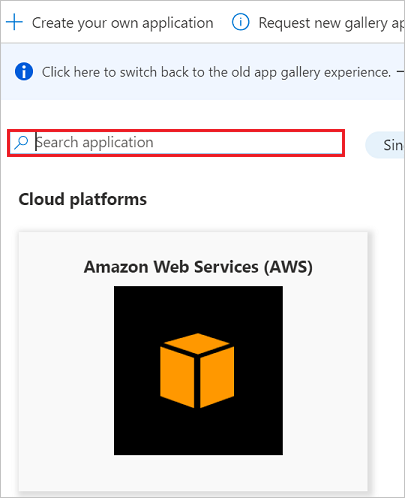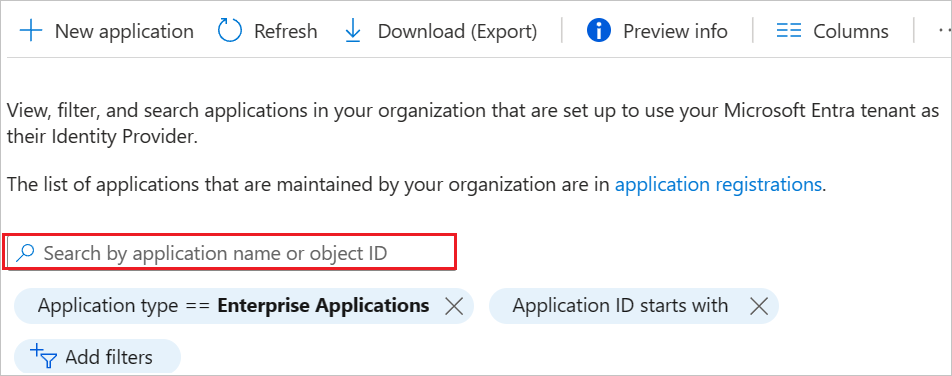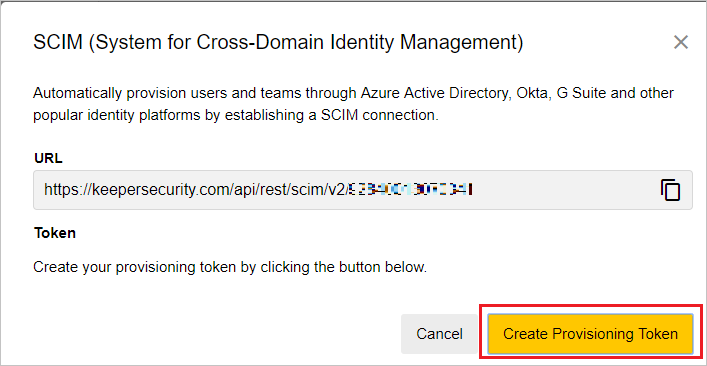Configure Keeper Password Manager & Digital Vault for automatic user provisioning
The objective of this article is to demonstrate the steps to be performed in Keeper Password Manager & Digital Vault and Microsoft Entra ID to configure Microsoft Entra ID to automatically provision and de-provision users and/or groups to Keeper Password Manager & Digital Vault.
Note
This article describes a connector built on top of the Microsoft Entra user Provisioning Service. For important details on what this service does, how it works, and frequently asked questions, see Automate user provisioning and deprovisioning to SaaS applications with Microsoft Entra ID.
Prerequisites
The scenario outlined in this article assumes that you already have the following prerequisites:
- A Microsoft Entra tenant
- A Keeper Password Manager & Digital Vault tenant
- A user account in Keeper Password Manager & Digital Vault with Admin permissions.
Add Keeper Password Manager & Digital Vault from the gallery
Before configuring Keeper Password Manager & Digital Vault for automatic user provisioning with Microsoft Entra ID, you need to add Keeper Password Manager & Digital Vault from the Microsoft Entra application gallery to your list of managed SaaS applications.
To add Keeper Password Manager & Digital Vault from the Microsoft Entra application gallery, perform the following steps:
- Sign in to the Microsoft Entra admin center as at least a Cloud Application Administrator.
- Browse to Identity > Applications > Enterprise applications > New application.
- In the Add from the gallery section, type Keeper Password Manager & Digital Vault, select Keeper Password Manager & Digital Vault in the search box.
- Select Keeper Password Manager & Digital Vault from results panel and then add the app. Wait a few seconds while the app is added to your tenant.

Assigning users to Keeper Password Manager & Digital Vault
Microsoft Entra ID uses a concept called assignments to determine which users should receive access to selected apps. In the context of automatic user provisioning, only the users and/or groups that have been assigned to an application in Microsoft Entra ID are synchronized.
Before configuring and enabling automatic user provisioning, you should decide which users and/or groups in Microsoft Entra ID need access to Keeper Password Manager & Digital Vault. Once decided, you can assign these users and/or groups to Keeper Password Manager & Digital Vault by following the instructions here:
Important tips for assigning users to Keeper Password Manager & Digital Vault
It is recommended that a single Microsoft Entra user is assigned to Keeper Password Manager & Digital Vault to test the automatic user provisioning configuration. Additional users and/or groups may be assigned later.
When assigning a user to Keeper Password Manager & Digital Vault, you must select any valid application-specific role (if available) in the assignment dialog. Users with the Default Access role are excluded from provisioning.
Configuring automatic user provisioning to Keeper Password Manager & Digital Vault
This section guides you through the steps to configure the Microsoft Entra provisioning service to create, update, and disable users and/or groups in Keeper Password Manager & Digital Vault based on user and/or group assignments in Microsoft Entra ID.
Tip
You may also choose to enable SAML-based single sign-on for Keeper Password Manager & Digital Vault, following the instructions provided in the Keeper Password Manager & Digital Vault single sign-on article. Single sign-on can be configured independently of automatic user provisioning, though these two features complement each other.
To configure automatic user provisioning for Keeper Password Manager & Digital Vault in Microsoft Entra ID:
Sign in to the Microsoft Entra admin center as at least a Cloud Application Administrator.
Browse to Identity > Applications > Enterprise applications

In the applications list, select Keeper Password Manager & Digital Vault.

Select the Provisioning tab.

Set the Provisioning Mode to Automatic.

Under the Admin Credentials section, input the Tenant URL and Secret Token of your Keeper Password Manager & Digital Vault's account as described in Step 6.
Sign in to your Keeper Admin Console. Click on Admin and select an existing node or create a new one. Navigate to the Provisioning tab and select Add Method.

Select SCIM (System for Cross-Domain Identity Management.

Click Create Provisioning Token.

Copy the values for URL and Token and paste them into Tenant URL and Secret Token in Microsoft Entra ID. Click Save to complete the provisioning setup on Keeper.

Upon populating the fields shown in Step 5, click Test Connection to ensure Microsoft Entra ID can connect to Keeper Password Manager & Digital Vault. If the connection fails, ensure your Keeper Password Manager & Digital Vault account has Admin permissions and try again.

In the Notification Email field, enter the email address of a person or group who should receive the provisioning error notifications and check the checkbox - Send an email notification when a failure occurs.

Click Save.
Under the Mappings section, select Synchronize Microsoft Entra users to Keeper Password Manager & Digital Vault.
Review the user attributes that are synchronized from Microsoft Entra ID to Keeper Password Manager & Digital Vault in the Attribute Mapping section. The attributes selected as Matching properties are used to match the user accounts in Keeper Password Manager & Digital Vault for update operations. Select the Save button to commit any changes.

Under the Mappings section, select Synchronize Microsoft Entra groups to Keeper Password Manager & Digital Vault.
Review the group attributes that are synchronized from Microsoft Entra ID to Keeper Password Manager & Digital Vault in the Attribute Mapping section. The attributes selected as Matching properties are used to match the groups in Keeper Password Manager & Digital Vault for update operations. Select the Save button to commit any changes.

To configure scoping filters, refer to the following instructions provided in the Scoping filter article.
To enable the Microsoft Entra provisioning service for Keeper Password Manager & Digital Vault, change the Provisioning Status to On in the Settings section.

Define the users and/or groups that you would like to provision to Keeper Password Manager & Digital Vault by choosing the desired values in Scope in the Settings section.

When you are ready to provision, click Save.

This operation starts the initial synchronization of all users and/or groups defined in Scope in the Settings section. The initial sync takes longer to perform than subsequent syncs, which occur approximately every 40 minutes as long as the Microsoft Entra provisioning service is running. You can use the Synchronization Details section to monitor progress and follow links to provisioning activity report, which describes all actions performed by the Microsoft Entra provisioning service on Keeper Password Manager & Digital Vault.
For more information on how to read the Microsoft Entra provisioning logs, see Reporting on automatic user account provisioning.
Connector Limitations
- Keeper Password Manager & Digital Vault requires emails and userName to have the same source value, as any updates to either attributes will modify the other value.
- Keeper Password Manager & Digital Vault does not support user deletes, only disable. Disabled users will appear as locked in the Keeper Admin Console UI.
Additional resources
- Managing user account provisioning for Enterprise Apps
- What is application access and single sign-on with Microsoft Entra ID?